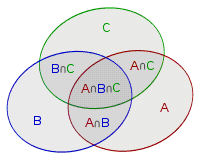#容斥定理
######参考文章:容斥定理详解
###摘要:
######原理描述:
计算几个集合并集的大小,先计算出所有单个集合的大小,减去所有两个集合相交的部分,加上三个集合相交的部分,再减去四个集合相交的部分,以此类推,一直计算到所有集合相交的部分 。具体如图:

######维恩图:

######概率论:
事件Ai(i=1,…,n),P(Ai)为对应事件发生的概率。至少一个事件发生的概率:

######方法论:
容斥常用二进制的方法进行枚举,第k位为1则表示选择了第k个数,用bits统计奇偶来确定符号,具体如下:
for(int i=1;i<(1<<k);++i)
{
bits=0;
for(int j=0;j<k;++j)
{
if((1<<j)&i)
{
/**视具体情况填写**/
++bits;
}
}
t=/** 计算交集的值 **/;
if(bits&1) ans+=t;
else ans-=t;
}
##例题
###codeforce gym 101350G. Snake Rana
######题意:
在一个nm的矩形里,有k个方格放置了炸弹,询问不包含炸弹的矩形有多少个?
######数据范围:
1
≤
N
,
M
≤
1
0
4
,
1
≤
K
≤
20
1 ≤ N, M ≤ {10^4}, 1 ≤ K ≤ 20
1 ≤ N, M ≤ 104,1 ≤ K ≤ 20
######题解:
nm的矩形中,共有
n
∗
(
n
+
1
)
2
frac{n*(n+1)}2
2n∗(n+1)*
m
∗
(
m
+
1
)
2
frac{m*(m+1)}2
2m∗(m+1)个矩形。(详见:矩形A+B)然后用位运算枚举包含炸弹的情况,用所有的情况减去包含炸弹的情况就是最终结果。
######代码:
#include <stdio.h>
#include <string.h>
#include <iostream>
#include <algorithm>
#define LL long long
using namespace std;
const int maxn=1e4+10;
int x[maxn],y[maxn];
int n,m,k;
LL f()
{
LL ans=0,t;
int x1,x2,y1,y2;
int bits=0;
for(int i=1;i<(1<<k);++i)
{
bits=0;
for(int j=0;j<k;++j)
{
if((1<<j)&i)
{
if(!bits) x1=x2=x[j],y1=y2=y[j];
else
{
x1=min(x1,x[j]);
y1=min(y1,y[j]);
x2=max(x2,x[j]);
y2=max(y2,y[j]);
}
++bits;
}
}
t=x1*1ll*(n-x2+1)*y1*(m-y2+1);
if(bits&1) ans+=t;
else ans-=t;
}
return ans;
}
int main()
{
int T;
scanf("%d",&T);
while(T--)
{
scanf("%d%d%d",&n,&m,&k);
for(int i=0;i<k;++i)
scanf("%d%d",&x[i],&y[i]);
LL ans=(m+1)*1ll*m*(n+1)*n/4;
ans=ans-f();
printf("%lldn",ans);
}
return 0;
}
###[HDU4135 - Co-prime](http://acm.hdu.edu.cn/showproblem.php?pid=4135) ######题意: 给定A,B,n,询问区间[A,B]中与n互质的数有多少个? ######数据范围: $1 <= A <= B <= {10^15}, 1 <=N <= {10^9}$ ######题解: A,B的数据范围太大,枚举显然不显示。互质就是指最大公约数为1,那么不互质就是有相同的大于1的公约数。把n进行因数分解,因数的倍数就是不互质的,用所有的方案数$-$不互质的就是结果,注意这里要进行容斥,因为会有类似于“2的倍数同样也是4的倍数,也是8的倍数...”这样的情况出现。 ######代码:
#include <stdio.h>
#include <string.h>
#include <iostream>
#include <algorithm>
#define LL long long
using namespace std;
const int maxn=1e5+10;
int a[maxn];
int main()
{
int T,c=1;
scanf("%d",&T);
LL L,R;
int n;
while(T--)
{
scanf("%lld%lld%d",&L,&R,&n);
--L;
int cnt=0;
for(int i=2;i*i<=n;++i)
{
if(n%i==0)
{
a[cnt++]=i;
while(n%i==0)
{
n=n/i;
}
}
}
if(n>1) a[cnt++]=n;
LL ans1=0,ans2=0,d;
int bits;
for(int i=1;i<(1<<cnt);++i)
{
d=1;
bits=0;
for(int j=0;j<cnt;++j)
{
if((1<<j)&i)
{
d=d*1ll*a[j];
bits++;
}
}
if(bits&1) ans1+=L/d,ans2+=R/d;
else ans1-=L/d,ans2-=R/d;
}
LL ans=R-L-(ans2-ans1);
printf("Case #%d: %lldn",c++,ans);
}
return 0;
}
最后
以上就是留胡子铃铛最近收集整理的关于数论 | 容斥定理的全部内容,更多相关数论内容请搜索靠谱客的其他文章。








发表评论 取消回复